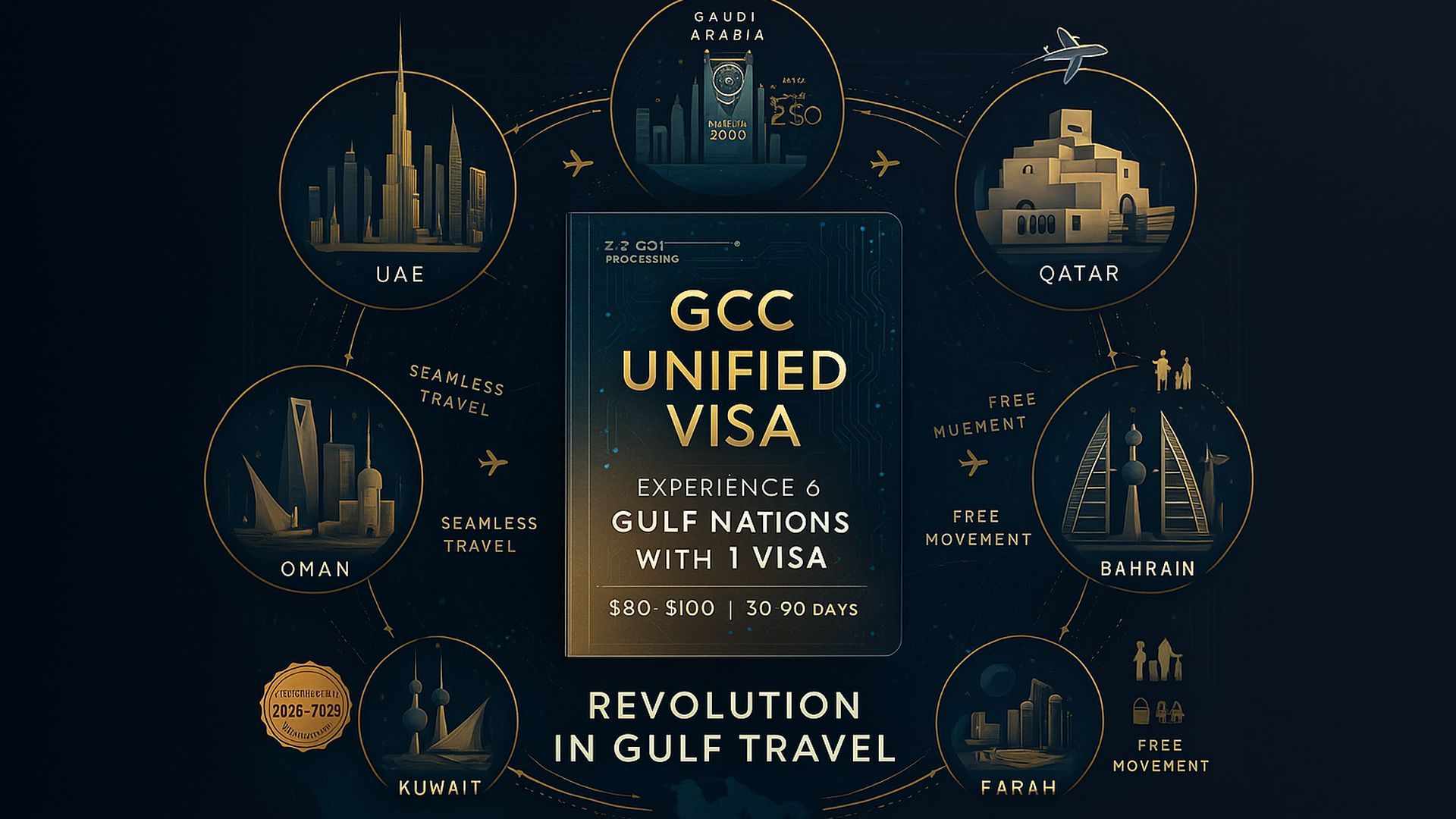5 Ways Schengen Visa Gulf Opens Up Amazing Gulf Adventures. The revolutionary Schengen Visa Gulf is set to transform Middle Eastern travel, offering unprecedented access to six Gulf countries with a single visa application. Expected to launch late 2024 or early 2025, this groundbreaking system enables travellers to seamlessly explore the UAE, Saudi Arabia, Qatar, Oman, Bahrain, and Kuwait, creating incredible opportunities for cross-country adventures. MK Travel Bag is already preparing exclusive packages to help travellers maximise this historic development in Gulf Tourism.
Amazing Adventures With Schengen Visa Gulf
1. Six Countries, One Visa: The Ultimate Gulf Grand Tour
The Schengen Visa Gulf eliminates the complex multi-visa process that previously limited Gulf exploration. Travellers can now experience Dubai’s futuristic skyline, Saudi Arabia’s ancient heritage sites, Qatar’s world-class museums, Oman’s dramatic landscapes, Bahrain’s pearl diving culture, and Kuwait’s rich trading history—all with one streamlined application.
Incredible Multi-Country Possibilities:
- The duration ranges from 30 to 90 days across all six GCC countries.
- A single online application can be submitted through the centralised GCC platform.
- The estimated cost is between $80 and $100, which is far less than the cost of individual country visas.
- Flexible entry through any of the six participating countries
This freedom creates entirely new travel experiences that were impossible under the previous system. MK Travel Bag’s Gulf specialists are designing comprehensive “Gulf Grand Tour” packages that showcase each country’s unique attractions while maximising the visa’s 90-day potential.
2. Enhanced Business and Investment Opportunities Across the Gulf
For international business travellers, Schengen Visa Gulf represents a game-changing development in regional commerce. Entrepreneurs can now attend conferences in Dubai, explore investment opportunities in Saudi Arabia’s NEOM project, meet clients in Doha’s financial district, and visit Omani industrial developments—all during a single business trip.
Business Travel Revolution:
- Attend multiple conferences and trade shows across the Gulf region
- Explore Saudi Vision 2030 projects and UAE innovation hubs
- Participate in Qatar’s growing sports and culture sectors
- Access Oman and Bahrain’s emerging tourism investments
- Build relationships across all six GCC markets efficiently
The GCC Unified Visa particularly benefits technology companies, real estate developers, and luxury goods distributors who require regular Gulf region business travel. Processing times of just 2-5 days make last-minute business opportunities more accessible.
3. Cultural and Heritage Discovery Across Ancient Trade Routes
The Schengen Visa Gulf opens remarkable opportunities for cultural immersion across civilisations that have shaped global trade for millennia. Travellers can trace ancient frankincense routes from Oman through Saudi Arabia, explore Islamic architecture evolution from Kuwait to the UAE, and experience Bedouin culture adaptations across all six countries.
Cultural Exploration Advantages:
- Follow historical trade routes connecting all six GCC countries
- Experience diverse Islamic architectural styles and cultural traditions
- Participate in festivals and cultural events across multiple nations
- Learn Arabic language variations and regional dialects
- Understand the Gulf’s pearl diving heritage from Bahrain to Kuwait.
This cultural access creates educational opportunities previously impossible due to visa complexities. Universities and cultural institutions are already planning exchange programs, leveraging the GCC’s Schengen Visa Gulf system.
4. Luxury Tourism Experiences Redefined
Gulf luxury tourism reaches new heights with the Schengen Visa Gulf, enabling unprecedented access to the region’s finest offerings. Travellers can experience Saudi Arabia’s luxury desert camps, the UAE’s world-class shopping and dining, Qatar’s exclusive sports events, Oman’s luxury eco-lodges, Bahrain’s heritage hotels, and Kuwait’s cultural luxury experiences.
Premium Gulf Experiences:
- Luxury train connections between GCC capitals (planned infrastructure)
- Exclusive desert safari expeditions across multiple countries
- Private yacht charters explore Gulf waters and pristine coastlines.
- Visitors can access the region’s most exclusive resorts and wellness retreats.
- Exclusive VIP experiences are available at major sporting events and cultural celebrations.
MK Travel Bag has partnered with luxury service providers across all six GCC countries to create bespoke experiences utilising the GCC Unified Visa’s freedom. These include private jet tours connecting Gulf cultural capitals and exclusive access to royal palaces and private estates.
5. Sports and Event Tourism Integration
The Schengen Visa Gulf perfectly aligns with the region’s massive investment in sports and cultural events. Visitors can attend multiple events across different countries during a single trip—from Formula 1 races to FIFA World Cup events, cultural festivals to business conferences.
Event Tourism Opportunities:
- Attend the Saudi World Cup 2034 with side trips to the UAE and Qatar
- Experience Formula 1 races in multiple GCC countries
- Participate in cultural festivals spanning several nations
- Combine business conferences with leisure tourism across the region
- Follow sports seasons and cultural calendars regionally
Extended visa duration allows travellers to time their visits with multiple events, creating comprehensive Gulf experiences that were previously logistically impossible.
Strategic Advantages Over Traditional Visa Systems
The Schengen Visa Gulf offers distinct advantages over existing regional visa systems. Unlike Europe’s Schengen area, with 27 countries requiring extensive processing times, the Gulf system focuses on six culturally connected nations with streamlined 2–5-day processing and digital-first applications.
System Advantages:
- Faster processing than European Schengen visas
- Culturally cohesive region with shared heritage and languages
- Focus on luxury and premium travel experiences
- Integration with major airline hubs (Emirates, Qatar Airways, Saudia)
- Alignment with regional Vision 2030 development goals
Preparing for the Launch: MK Travel Bag’s Expert Guidance
Understanding and maximising Schengen Visa Gulf opportunities requires expert planning and regional knowledge. The Gulf specialists at MK Travel Bag are already preparing comprehensive services, including visa consultation, multi-country itinerary design, accommodation booking across all six countries, and 24/7 support throughout extended Gulf adventures.
Our preparation includes partnerships with tour operators, hotels, and cultural institutions across all GCC countries, ensuring seamless experiences when the visa launches officially.
Future Expansion and Regional Integration
The Schengen Visa Gulf represents just the beginning of Gulf regional integration. Tourism officials from all six countries emphasise this as a partnership rather than a competition, with plans for shared tourism marketing, integrated transportation systems, and coordinated cultural programming.
Early indicators suggest potential expansion to include Jordan and other regional partners, creating an even larger unified travel zone in the Middle East.
Conclusion: Your Gulf Adventure Revolution Awaits
The GCC Unified Visa transforms Gulf travel from a complex multi-visa challenge into an accessible gateway for incredible regional adventures. Whether pursuing business opportunities, cultural exploration, luxury experiences, or sports tourism, travellers will soon enjoy unprecedented freedom to discover the Gulf’s combined attractions.
With the official launch expected in late 2024 or early 2025, now is the perfect time to start planning your comprehensive Gulf adventure. Contact MK Travel Bag’s regional specialists to prepare for this historic opportunity and design your perfect multi-country Gulf experience.
Be among the first to experience the Gulf like never before with MK Travel Bag’s expert guidance and the revolutionary freedom that the GCC Unified Visa provides.


